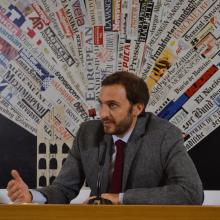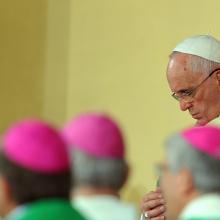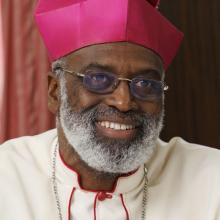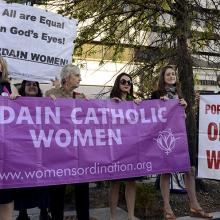vatican

Image via REUTERS / Andrew Medichini / Pool / RNS
The Vatican has said that Catholics should witness to their faith but not undertake organized efforts to convert Jews, a significant step forward in the once tense relations between the two faiths.
The document released on Dec. 10 by the Vatican’s Commission for Religious Relations With the Jews also pushed for greater efforts to fight anti-Semitism.
In its most explicit commentary on evangelization regarding Jews, the document said Catholics should take a different approach to Judaism than to other religions.

Screenshot via vatican / Youtube
An extraordinary illuminated projection of images of the natural world onto St. Peter’s Basilica on the evening of Dec. 8 drew thousands of awed spectators to the Vatican and delighted untold numbers more watching online and via widespread media coverage of the three-hour show.
But not everyone was happy with the spectacle, not by a long shot, as social media and conservative Catholic sites erupted with indignation.
“This has gone beyond ridiculous,” fumed a conservative blogger, the Rev. John Zuhlsdorf, who called it “irreverent” to use a sacred space for a secular purpose.
“Why not rent out the Sistine chapel too, while they’re at it?”

Image via Osservatore Romano / Handout via Reuters / RNS
Pope Francis launched the jubilee of mercy on Dec. 8 with the opening of the Vatican’s holy door, joined by his predecessor Pope Emeritus Benedict XVI, and thousands of pilgrims gathered in St. Peter’s Square, surrounded by heavy security.
“This extraordinary year is itself a gift of grace,” Francis told the faithful gathered at the Vatican.
“To pass through the holy door means to rediscover the infinite mercy of the Father who welcomes everyone and goes out personally to encounter each of them.”

Image via f11photo / Shutterstock.com
In the Catholic Church, a jubilee — or a holy year — is a religious event that involves the forgiveness of sins, as well as reconciliation. But the idea of a jubilee dates back to the Bible: “And you shall sanctify the fiftieth year, and proclaim freedom throughout the land for all who live on it,” Leviticus 25:10. For the ancient Israelites, the jubilee was a time properties were returned to their original owners or legal heirs, slaves were set free, and creditors were barred from collecting debts.
Pope Boniface VIII in 1300 declared the first Christian jubilee, beginning with the opening of the Holy Door, an entrance to St. Peter’s Basilica, usually blocked, through which pilgrims can enter. Other holy doors are also opened for this jubilee in Rome and around the world for the first time; the year ends when they are closed.
On Nov. 29 Pope Francis opened a door at the cathedral in Bangui, the capital of the Central African Republic, as a symbolic start to the Holy Year.

Emiliano Fittipaldi. Image via Rosie Scammell / RNS
An Italian investigative journalist on Nov. 17 spoke out against what he called a “medieval” Vatican law that might result in a jail sentence of up to eight years for publishing confidential Holy See documents.
Emiliano Fittipaldi, whose new book Avarice reveals the struggle for financial reform at the Vatican, is under investigation for publishing secret documents leaked from the Holy See. A fellow Italian journalist, Gianluigi Nuzzi, is also being investigated for revelations made in his book, Merchants in the Temple.
While describing the investigation as “a terrible moment,” Fittipaldi remained defiant:
“From my point of view they are crazy charges, in the sense that in no democratic state, in no Western democracy, are there such restrictive laws on press freedom and expression.”

Image via Sally Morrow / RNS
Pope Francis on Nov. 11 urged Catholics to continue the tradition of a family meal, leaving smartphones aside, and switching off the TV to enjoy the “fundamental experience” of sharing food.
“The sharing of a meal — and therefore, other than of food, also of affections, of stories, of events — is a fundamental experience,” Francis said during his weekly audience in St. Peter’s Square.
Sitting around the table helps measure the health of relationships, the pontiff said: “If in a family there’s something that doesn’t work, or a hidden wound, at the table it’s understood immediately.”

Image via Stefano Rellandini / REUTERS / RNS
Pope Francis made a whirlwind trip to Tuscany on Nov. 10, during which he addressed immigrant workers, called on Italian bishops to shun power, and celebrated Mass with thousands of followers in Florence’s soccer stadium.
Francis started his packed, daylong schedule with a helicopter flight to Prato, known for its textile industry and large Chinese community. Crowds waving the Vatican’s yellow and white flag met him on his arrival.
The pope called for an end to labor exploitation, addressing the deaths of seven Chinese workers in a nighttime factory fire in 2013.
“It is a tragedy of exploitation and of inhumane conditions of life. And this is not undignified work,” he said.

Image via Alessandro Bianchi / REUTERS / RNS
Pope Francis on Nov. 8 broke his silence over the leaking of confidential Vatican documents, which he described as a “deplorable act” that will not stand in the way of his ambitious reform agenda.
Speaking to followers in St. Peter’s Square, the pontiff criticized revelations made in two books published last week that explore Francis’ efforts to overhaul financial mismanagement within the Vatican walls.
“Stealing those documents was a crime. It’s a deplorable act that does not help,” the pope said, adding that the leaked information was based on a study he had personally requested.

Image via Grant Gallicho / RNS
The document would become known as the Pact of the Catacombs, and the signers hoped it would mark a turning point in church history.
Instead, the Pact of the Catacombs disappeared, for all intents and purposes.
It is barely mentioned in the extensive histories of Vatican II, and while copies of the text are in circulation, no one knows what happened to the original document. In addition, the exact number and names of the original signers is in dispute, though it is believed that only one still survives: Luigi Bettazzi, nearly 92 years old now, bishop emeritus of the Italian diocese of Ivrea.
Catholic leaders made a rare appeal to the world’s politicians on Oct. 26, urging them to take strong action at the highly-anticipated U.N. climate change summit later this year.
Nine cardinals, patriarchs, and bishops representing the Catholic Church across five continents signed a document, presented at the Vatican on Oct. 26 by clergy from Belgium, Colombia, India, and Papua New Guinea.
The document presents a 10-point policy proposal calling for “a fair, legally binding, and truly transformational climate agreement.”

Image via Alessandro Bianchi / REUTERS / RNS
The most significant and contested gathering of Roman Catholic bishops in the last 50 years formally ended on Oct. 25 after three weeks of debate and dispute, but the arguments over who “won” and who “lost” are only beginning.
The synod of 270 cardinals and bishops from around the world was the second in a year called by Pope Francis to address how and whether Catholicism could adapt its teachings to the changing realities of modern family life. Traditionalists had taken a hard line against any openings, especially after last October’s meeting seemed to point toward possible reforms.
While the delegates made hundreds of suggestions on a host of issues, two took center stage, in part because they represented a barometer for the whole question of change: Could the church be more welcoming to gays, and was there a way divorced and remarried Catholics could receive Communion without an annulment?

Image via Alessandro Bianchi / REUTERS / RNS
The overriding interest in the global meeting of Roman Catholic bishops that finishes here on Oct. 25 has centered on whether the churchmen will actually do anything in the end — as in vote to make changes in church doctrines or policies — or leave well enough alone.
In reality, the gathering of 270 bishops from around the world, called a synod, has no authority to legislate doctrinal or other changes, and wasn’t expected to try anything that bold anyway.
Its real purpose — thanks to reforms instituted by Pope Francis — is to discuss issues openly and frankly, and to advise the pontiff about what they think the church ought to do about the challenges facing families today, or, as is likely the case for this divided synod, to kick the hard questions upstairs for him to decide.

Image via Max Rossi / REUTERS / RNS
The rows of seats in the synod hall, where Catholic bishops are meeting to discuss family issues, are filled with bishops and cardinals — all male. To find any women, look to the back of the room.
The women’s distance from the heart of the synod hall reflects fears raised by women’s groups that their participation is a mere token on the Vatican’s part.
There are 270 bishops and cardinals participating in the synod and voting on its outcome. A number of other participants, including lay couples and representatives from other churches, have been invited to give their opinions but will not be able to make decisions on the final text. That includes more than two dozen women who have been called to present their views.
Barrels of ink, digital and real, have been spilled by journalists trying to convey the gravity of the high-stakes debate on church teaching in Rome this month, as the melodrama that a closed-door Vatican gathering of some 270 churchmen almost guarantees.
The synod, as it’s called, has it all: steady leaks to the press, rumors of lavish dinners and reports of intense lobbying, plus open disagreements over doctrine. It’s a steady diet of soap opera and theology, and almost too much for any reporter to keep up with.
Which is why, if you want to know what it’s like to be a player in such an event, and in the extracurricular socializing where much of the work is done, you have to read the blog of Australian Archbishop Mark Coleridge.

Image via giulio napolitano / Shutterstock
Francis’ visit was said to have delighted around 30 homeless men hosted at the dormitory, who spoke to the pope, recounted their stories and asked to be blessed. The pontiff’s visit lasted around 20 minutes, Vatican Radio reported.
He was accompanied by his almoner (distributor of alms or charity), Archbishop Konrad Krajewski; the Jesuit superior general, the Rev. Adolfo Nicolas; and three nuns who work at the residence.
The “Gift of Mercy” (“Dono di Misericordia”) homeless shelter was inaugurated earlier this month and can host 34 people each night. The building, a former travel agency, was converted by Jesuits as a response to Francis’ call for more to be done to help poor people.

Image via miqu77 / Shutterstock
Pope Francis on Oct. 14 asked forgiveness for a series of scandals that have befallen the Vatican and Rome.
Francis did not specify the scandalous events to which he was referring, although the departure of a gay cleric earlier this month may well have been on the pontiff’s mind.
“I ask you for forgiveness for the scandals that have occurred recently either in Rome or in the Vatican,” the pope said during his weekly general audience in St. Peter’s Square.

Archbishop Charles G. Palmer-Buckle of Accra. Image via Nancy Wiechec / Catholic News Service / RNS
Ghanaian Archbishop Charles Palmer-Buckle on Oct. 8 defended African bishops’ role in the Vatican’s meeting on family issues, stating they were not in Rome to block progress but to present their own views.
As bishops get to work discussing key issues affecting family life at the meeting, known as a synod, they have broken into small language-based groups. Palmer-Buckle was responding to a question at a press conference suggesting that African bishops were trying to stop “progress.”
“If someone thinks Africa is blocking something, it’s only proposing what we feel,” he told journalists at the Vatican.
“We’re not here to block anybody.”

Image via Mike Theiler / REUTERS / RNS
The most controversial proposal floated so far at the high-level, high-stakes Vatican summit on church teachings on the family had nothing to do with gays or divorce, but instead ordaining women — not as priests, but as deacons.
Still, even that suggestion — made by a Canadian archbishop on Oct. 6, near the start of the closely watched, three-week synod called by Pope Francis — was considered eye-popping.
That’s because if the trial balloon floated by Quebec Archbishop Paul-Andre Durocher flies, it would represent a historic breakthrough for the Catholic Church, and Catholic women, by giving them access to the kinds of offices that only priests and bishops can hold.
“We do not remember days,” the Italian poet Cesare Pavese said, “we remember moments.”
Pavese’s words have come to mind often as I’ve thought about Pope Francis’ historic visit to the United States, particularly when people have asked me what the “best part” of covering the papal visit was for me.
My answer is always the same: hands down the best part was watching people see (and sometimes meet) Pope Francis in person for the first time.

Image via Max Rossi / REUTERS / RNS
The Vatican’s high-level meeting on the family continued Oct. 6, with bishops emphasizing the need for open discussion on divorced and remarried Catholics.
The 62 bishops who have so far spoken at the gathering, called a synod, appeared to push back strongly against remarks Monday by Hungary’s Cardinal Peter Erdo, who defended the church’s exclusion of divorced and remarried couples from receiving Communion unless they’ve been granted an annulment and remarried in the church.
Speaking to journalists on Tuesday, Archbishop Claudio Maria Celli, president of the Pontifical Council for Social Communications, said there would be an open discussion on the topic.
“The synod has a wide vision … of the universal church,” Celli said.


